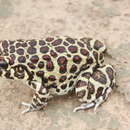Distribution
provided by IABIN
Gran Chaco of Paraguay, Bolivia, and Argentina.
- author
- Esteban O. Lavilla
- editor
- Diego Arrieta
Diagnostic Description
provided by IABIN
Adult morphology Snout-vent up to 115-120 mm in large specimens. No difference in size between males and females. Head broad and stout, wider than large, obtusely rounded. Snout short and slightly truncate in profiIe. Nostrils closer to the tip of snout than to the eye; internarial interval equal to the interocular distance and to the upper eyelid. Canthus rostralis round; loreal region sloping to meet the upper lip, very thick and prominent in this species. Eyes prominent; their diameter equal to their distance from nostrils. Maxillary teeth strong; vomerine teeth in two exceedingly heavy, nearly contiguous patches, between and behind the choanae. Tongue wide, cordiform, notched and free behind. Tympanurn round very distinct, almost equal to the eye diameter. A curved dermal foId from the posterior corner of the eye to the axilla. Fingers fringed, rounded, gently dilated on the tip. Rate of the finger lengths: II-IV-I-III. Subarticular tubercles blunt and prominent. Strong, ova1 metacarpal tubercles. Toes unwebbed but distinctly fringed; inner metatarsal tubercle small, oval-shaped and blunt: a very faint outer metatarsal tubercle and a weak, smooth tarsal fold. A prominen spur is located outside in the first finger, ending in a black sharply pointed thorn in males. Another black thorn projects at the baw of the inner metacarpal tubercle. Besides these secondary sex chalacters the males have bilateral black thorny patches on the chest, When hindleg is adpressed, heel reaches the tympanum; when the femurs are bent at right angles to body, the tibio-tarsal articulations touch. Skin smooth and porous, dorsally scattered with many flat glandular patches. Belly smooth; the lower posterior surface of thighs closely granular. Color in life: Whitish or yellowish on the back, scattered with rounded symmetrical red spots, dark-edged and brilliant. Dark brown transverse bands on forelegs and hindlegs, speckled with red. Belly whitish, allmost immaculate, except in a number of faintIy brown spots on throat and chest.
- author
- Esteban O. Lavilla
- editor
- Diego Arrieta
Comprehensive Description
provided by Smithsonian Contributions to Zoology
Leptodactylus laticeps Boulenger, 1918
Leptodactylus laticeps Boulenger, 1918:431. [Type-locality: Santa Fe, Argentina. Holotype: BMNH 98.11.24.7]
DIAGNOSIS.—Leptodactylus laticeps is the most distinctive member of the pentadactylus group. The dorsum color is apparently a warning color, with black squares and rectangles enclosing red on a yellow background. In preservative, the black squares and triangles have white areas within and are separated by white areas. The black markings are in a tile-like pattern (Figure 1, F). No other member of the group has a pattern approaching a tile floor.
ADULT CHARACTERISTICS (N=15).—Dorsum with distinct pattern of dark square and rectangular spots enclosing light areas (Figure 1, F); lip with light narrow vertical bars (Figure 2, I); posterior surface of thigh with bold light marks on a darker background (Figure 3, J, K); upper tibia with broad bands (Figure 4, A); no dorsolateral folds; fold from eye over tympanum to shoulder not distinctively marked; no fold from above tympanum to side of body; male with two thumb spines per hand; male chest spines usually present; upper tibial and distal surfaces smooth; sole of foot smooth or very scatterted with white tubercles; female SVL 106.1±6.5 mm, maximum 113.4 mm, males SVL 97.7±2.7 mm, maximum 110.0 mm; female interorbital distance/head length ratio 0.16±0.01, male 0.15±0.02; female eye-nostril distance/head length ratio 0.24±0.01, male 0.24±0.01; female head length/SVL ratio 0.36±0.01; male 0.36±0; female head width/SVL ratio 0.38±0.01, male 0.39±0.01; female femur/SVL ratio 0.39±0.03, male 0.40±0.01; female tibia/SVL ratio 0.39±0.02, male 0.40±0.01; female foot/SVL ratio 0.36±0.02, male 0.38±0.01.
DISTINCTIVE COLORS IN LIFE.—This species is quite bright, having irregular black squares and rectangles enclosing bright red, separated by bright yellow.
LARVAL CHARACTERISTICS.—Unknown.
MATING CALL.—Unknown.
KARYOTYPE.—Unknown.
DISTRIBUTION (Figure 7).—This is the southernmost member of the pentadactylus group, found in the Gran Chaco and Santiago del Estero region of Argentina.
ARGENTINA. FORMOSA: Bañados del Río Teuco, Bermejo (FML 1049); Ingeniero Juárez (FML 591, 693, 885, UMMZ 109755(3)); Lag. Vaca Perdida, 50 km Río Pilcomayo (FML 612). SALTA: Hickmann (FML 159–61, 269, 280, 389–90, 415–16, 427, 436–37, 459, 862). SANTIAGO DEL ESTERO: Bandera Bajada, 15 km from between km 30 and La Invernada (Dept Figueroa) (FML 2181, USNM 195960(2)); Caspi Corral, 96 km from Santiago del Estero (FML 2183–84, USNM 195961(2)); Loreto, 46 km S (MCZ 33943); Paraje Monte Redondo, Dept Loreto (FML 2434).
- bibliographic citation
- Heyer, W. Ronald. 1979. "Systematics of the pentadactylus species group of the frog genus Leptodactylus (Amphibia, Leptodactylidae." Smithsonian Contributions to Zoology. 1-43. https://doi.org/10.5479/si.00810282.301
Leptodactylus laticeps: Brief Summary
provided by wikipedia EN
Leptodactylus laticeps is a species of frog in the family Leptodactylidae.
It is found in Argentina, Bolivia, and Paraguay. Its natural habitats are subtropical or tropical dry forests, dry savanna, subtropical or tropical dry shrubland, subtropical or tropical moist shrubland, and intermittent freshwater marshes. It is becoming rare due to habitat loss.
- license
- cc-by-sa-3.0
- copyright
- Wikipedia authors and editors

